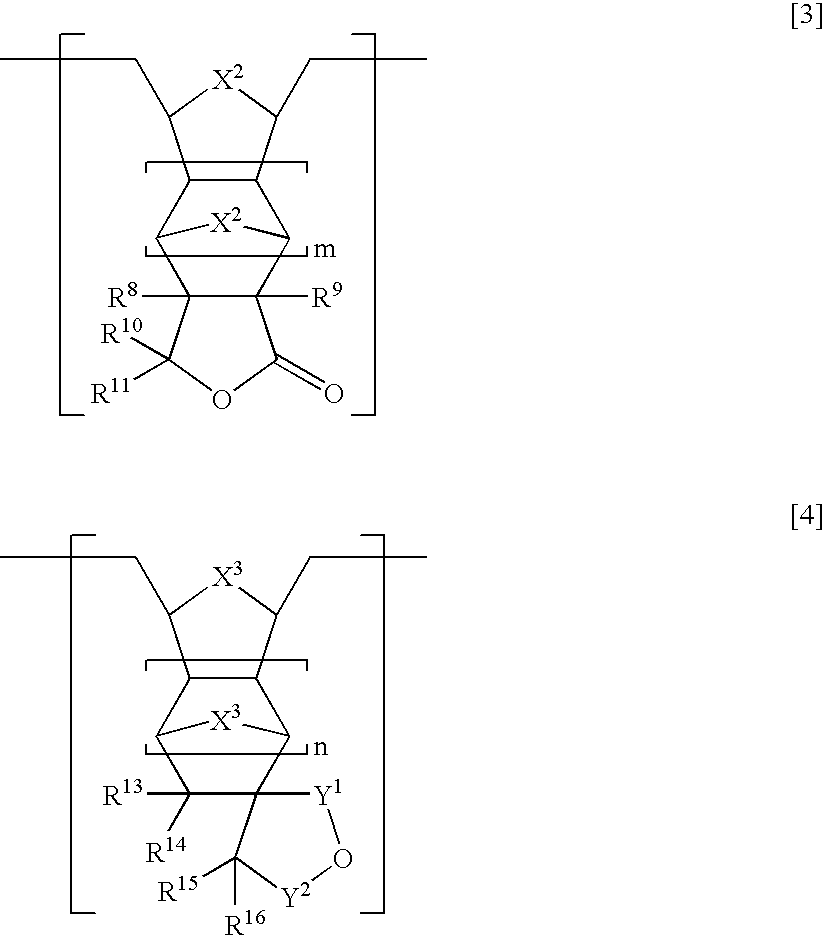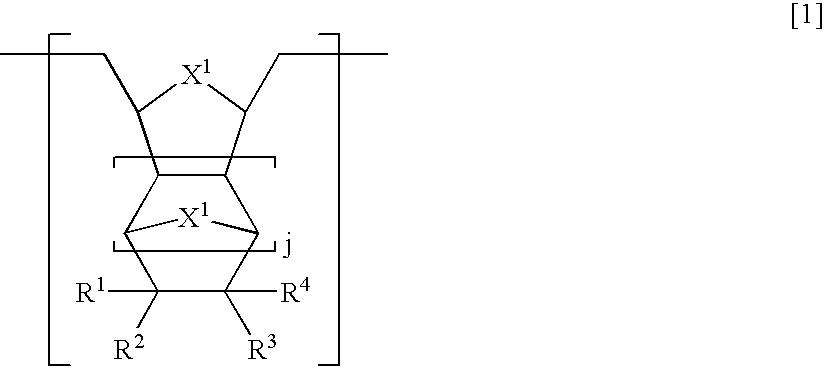Hydrogenated ring-opening metathesis polymer and process for producing the same
a technology of metathesis and polymer, applied in the field of hydrogenated ring-opening metathesis polymer, can solve the problem of narrow range of practical conditions for applying the polymer, and achieve the effect of easy formation of films of different thicknesses and good film formability
- Summary
- Abstract
- Description
- Claims
- Application Information
AI Technical Summary
Benefits of technology
Problems solved by technology
Method used
Image
Examples
example 1
[0210]In a 300 ml Schlenk flask, 3,6-epoxy-1,2,3,6-tetrahydrophthalide (4.33 g, 28.5 mmol) and 8-(1′-ethylcyclopentoxy)carbonyltetracyclo[4.4.0.12,5.17,10]-3-dodecene (8.56 g, 28.5 mmol) as cyclic olefin monomers were dissolved in 100 ml of tetrahydrofuran (hereinafter, referred to as THF) under a nitrogen atmosphere. To this was added 0.37 ml of 1,5-hexadiene (3.2 mmol) as a chain transfer agent and the mixture was stirred and then Mo(N-2,6-Pri2C6H3)(CHCMe2Ph)(OCMe(CF3)2)2 (40 mg, 0.052 mmol) as a ring-opening metathesis polymerization catalyst was added thereto and the mixture was stirred at room temperature for 1 hour. Then, 3,6-epoxy-1,2,3,6-tetrahydrophthalide (4.33 g, 28.5 mmol), 8-(1′-ethylcyclopentoxy)carbonyltetracyclo[4.4.0.12,5.17,10]-3-dodecene (8.56 g, 28.5 mmol) and 0.74 ml of 1,5-hexadiene (6.4 mmol) dissolved in 100 ml of THF was added to the polymerization solution simultaneously with a solution of Mo(N-2,6-Pri2C6H3)(CHCMe2Ph)(OCMe(CF3)2)2 (40 mg, 0.052 mmol) in THF...
example 2
[0215]In a 2000 ml eggplant type flask, 20.0 g of the hydrogenated ring-opening metathesis polymer obtained in Example 1 was added to a solution of 5.0 ml of trifluoroacetic acid in 1000 ml of toluene, and the mixture was stirred at 70° C. for 2 hours, the solvent was distilled off, and then the resulted mixture was further dissolved in THF, added into methanol, filtrated and dried in vacuum to provide 18.2 g of a hydrogenated ring-opening metathesis polymer which was partially ester-decomposed in the form of a white powder. The composition ratio of the structural units [A] / [B] / [D] in the resulted polymer was 35 / 50 / 15, and the number-average molecular weight Mn measured by GPC was 23000 and Mw / Mn was 3.69.
[0216]Thus obtained polymer was prepared as a film in the same manner as in Example 1. The solution of 5% bt weight was applied at 3000 rpm and dried to give a uniform film of 0.26 μm, and further with the solution of 10% by weight, to give a uniform film of 0.50 μm thickness.
example 3
[0219]In a 300 ml Schlenk flask, 3,6-epoxy-1,2,3,6-tetrahydrophthalide (8.66 g, 57.0 mmol), 8-(1-ethylcyclopentoxy)carbonyltetracyclo[4.4.0.12,5.17,10]-3-dodecene (17.12 g, 57.0 mmol) and 0.74 ml of 1,5-hexadiene (6.4 mmol) as cyclic olefin monomers were dissolved in 200 ml of THF under a nitrogen atmosphere. To this was added W(N-2,6-Pri2C6H3)(CHCMe2Ph)(OCMe(CF3)2)2 (17 mg, 0.02 mmol) as a ring-opening metathesis polymerization catalyst, the mixture was stirred at room temperature for 10 minutes, a solution of 68 mg (0.08 mol) of the same catalyst in THF was further added thereto and the mixture was further stirred at room temperature for 1 hour. Then, butylaldehyde (26 mg, 0.36 mmol) was added thereto and the mixture was stirred for 30 minutes.
[0220]The obtained polymerization solution was hydrogenated in the same manner as in Example 1 to give 25.6 g of a hydrogenated ring-opening metathesis polymer having 100% hydrogenation rate in the form of a white powder. Mw in terms of poly...
PUM
| Property | Measurement | Unit |
|---|---|---|
| wavelength | aaaaa | aaaaa |
| wavelength | aaaaa | aaaaa |
| wavelength | aaaaa | aaaaa |
Abstract
Description
Claims
Application Information
 Login to View More
Login to View More - R&D
- Intellectual Property
- Life Sciences
- Materials
- Tech Scout
- Unparalleled Data Quality
- Higher Quality Content
- 60% Fewer Hallucinations
Browse by: Latest US Patents, China's latest patents, Technical Efficacy Thesaurus, Application Domain, Technology Topic, Popular Technical Reports.
© 2025 PatSnap. All rights reserved.Legal|Privacy policy|Modern Slavery Act Transparency Statement|Sitemap|About US| Contact US: help@patsnap.com



